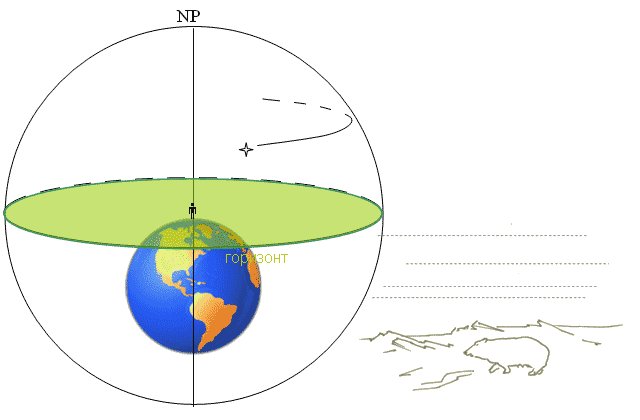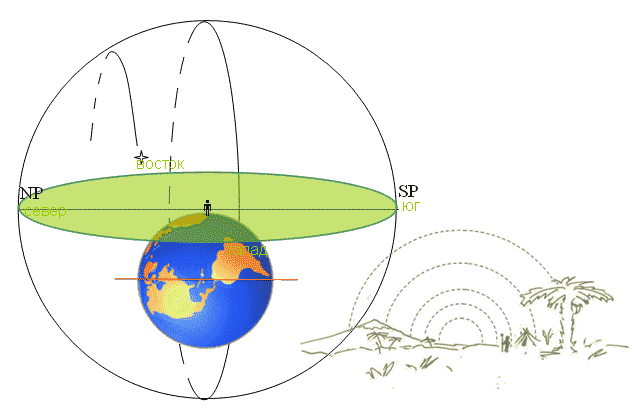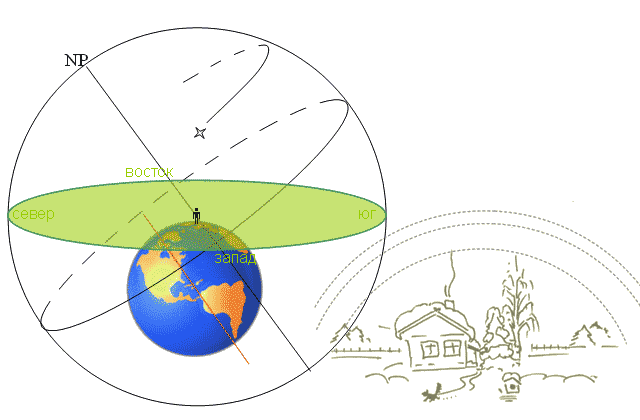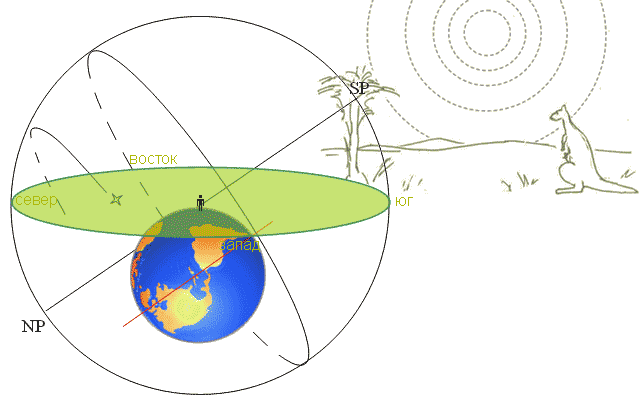Celestial sphere
For many centuries, the “firmament of the earth” was considered a model of inviolability and immobility. It is not surprising that this mistake lasted so long, because all our senses speak of the immobility of the Earth and the rotation of the “vault of heaven” with the stars, the Sun and the Moon around it. But even now in astronomy, as a memory of those ancient times, the concept of the celestial sphere is used - an imaginary infinitely large sphere, in the center of which the observer is located and on the surface of which the movements of the celestial bodies are displayed.
Of course, the most noticeable thing is the daily rotation of the sky - the Sun rises in the morning, passes across the sky and falls below the horizon, the stars that are visible in the east in the evening rise high in the south by midnight and then fall to the west, the Sun rises again... It seems that the sky rotates around an invisible axis located near the North Star.
![]()
The movement of stars around the celestial pole. Photo by A. Mironov
But the daily rotation of the sky is very dependent on our position on the globe - if we find ourselves in the southern hemisphere, it will be very unusual for us that the Sun moves across the sky in the opposite direction - from right to left. Let's take a closer look at how the apparent rotation of the sky changes in different places on Earth.
To begin with, you should remember that the height of the Celestial Pole (the point around which the sky rotates) above the horizon is always equal to the geographic latitude of the observation site. This means that at the north pole the North Star will be at its zenith, and all the luminaries will move in a daily rotation from left to right parallel to the horizon, never rising or setting. Being at the pole, we could see the stars of only one hemisphere, but on any night. 
On the contrary, for an observer at the equator there are no non-rising stars (as well as non-setting ones) - all the stars in the sky are available for observation, they rise vertically in the eastern part of the horizon and exactly 12 hours later they set in the western part of the sky.

In mid-latitudes, some of the stars in the vicinity of the pole never fall below the horizon, but the same area of the sky around the opposite pole is never accessible for observation, while the remaining stars, a strip located on both sides of the celestial equator, rise and set during the day.

The movement of the luminaries in the middle latitudes of the southern hemisphere will look approximately the same, with the only difference being that the southern Pole of the World will be visible above the horizon, around which the stars rotate clockwise, and the familiar equatorial constellations, turned upside down, rise highest in the northern part of the sky and move from right to left.

Movement of the Sun and the day
Speaking about the movement of stars, we were not interested in the distance to them and the movement of the Earth around the Sun - the distances to the stars are enormous and changes in their positions due to the annual movement of the Earth are very small and can only be measured with very precise instruments. The Sun is a completely different matter. The motion of the Earth in its orbit results in the apparent motion of the Sun among the stars. The path that the Sun takes in the sky during the year is called the ecliptic. Since the earth's axis is tilted by 23.5°, when the earth revolves around the sun, either the northern or the southern hemisphere turns towards it - this explains the change of seasons on our planet.
When the northern hemisphere is turned towards the Sun - summer begins there, the Sun in its visible path along the ecliptic ends up in its northern part and in our northern hemisphere it rises higher above the horizon. At the North Pole, the Sun becomes a never-setting luminary for six months - polar day begins there. A little further south, the polar day lasts less and at the latitude of the Arctic Circle (66.5° - the Arctic Circle is 23.5° from the pole) the Sun does not set for only a few days in midsummer, near the summer solstice (June 22). In winter, the Sun does not rise at the pole for almost six months (a little less due to refraction), further south the polar night becomes shorter and shorter, and outside the Arctic Circle the Sun rises above the horizon even in the middle of winter.
In the middle and equatorial latitudes, the Sun always rises and sets, the length of the day strongly depends not only on the time of year, but also on the latitude - the closer to the equator, the less the difference between the length of the day in winter and summer and the closer the length of day and night is to 12 hours. But only at the equator is the length of day and night always constant. The duration of twilight also depends on latitude - in equatorial latitudes the Sun sets perpendicular to the horizon and twilight is the shortest, and at the latitude of St. Petersburg in mid-summer they last from sunset to sunrise - these are the famous white nights.
How high the Sun can rise above the horizon depends on latitude - on the day of the solstice this height will be 90°-φ+23.5°.
By the way, there is a very common misconception that at the equator the Sun is always at its zenith at noon - this is not true at any point on the Earth lying between the lines of the tropics (from 23.5°S to 23.5°N. ) exactly through the zenith, the Sun passes only twice a year, at the equator - on the days of the equinoxes, and along the lines of the tropics - only once a year, on the day of the summer solstice in the northern tropic and on the day of the winter solstice - in the southern tropic.
The movement of the Earth around the Sun leads to another important phenomenon - the duration of the solar day (the period of time between two noons) does not coincide with the sidereal day (the period of time between the passage of a star through the meridian). The fact is that the Earth needs additional time to rotate through the angle that it passes through its orbit per day. Moreover, the length of the solar day is not constant (see the article Equation of Time). It is easy to make a rough estimate - in a day the earth travels 1/365 of its orbit, or a little less than 1°, and if the Earth rotates around its axis (360°) in approximately 24 hours, then it will rotate 1° in about 4 minutes. Indeed, a sidereal day is 23 hours 56 minutes 4 seconds.
Moon
Since ancient times, our satellite has served people to keep track of time, and this is no coincidence - the change in the phases of the Moon is easy to observe and the length of the month is not difficult to determine, in addition, the month has become a very convenient intermediate unit of measuring time between a day and a year. By the way, the familiar seven-day week is also associated with the Moon - 7 days is approximately a quarter of a month (and the phases of the Moon are also measured in quarters). Most ancient calendars were lunar and lunisolar.

Of course, the first thing that catches your eye when observing the Moon is the change in its appearance over the course of a month from a thin crescent, which can be seen immediately after sunset 2-3 days after the new moon, to the first quarter phase (in the northern hemisphere the right half of the disk is illuminated Moon), then to the full moon, the last quarter (the left half of the disk is illuminated) and, finally, to the new moon, when the Moon approaches the Sun and disappears in its rays. The change in phases is explained by a change in the position of the Moon relative to the Sun as it revolves around the Earth; the full cycle of phase changes - a revolution relative to the Sun or a synodic month lasts about 29.5 days. The period of revolution relative to the stars (sidereal month) is slightly shorter and amounts to 27.3 days. As you can see, a year contains a non-integer number of months, so lunisolar calendars use special rules for alternating 12-month and 13-month years, because of this they are quite complex and are now in most countries replaced by the Gregorian calendar, which has nothing to do with the Moon - in memory of his predecessors, only months (though longer than lunar) and weeks remained...
There is another interesting feature in the movement of the Moon - the period of its rotation around its axis coincides with the period of revolution around the Earth, therefore our satellite is always turned towards the Earth with one hemisphere. But we cannot say that we can see only half of the Moon’s surface - due to the unevenness of the Moon’s orbital motion and the inclination of its orbit to the Earth’s equator, relative to the Earth’s observer, the Moon rotates slightly in both latitude and longitude (this phenomenon is called libration) and we can see the edge zones of the disk - in total, about 60% of the lunar surface is accessible to observations.

Jean Effel, "Creation of the World"
-It's not easy to start a universe!








